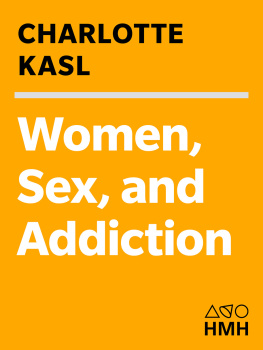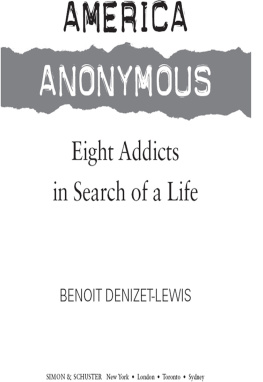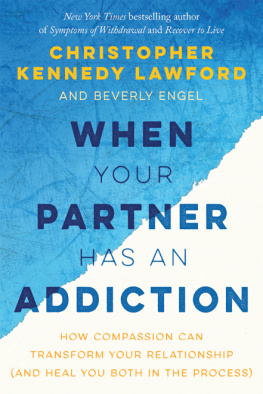Copyright 1989 by Charlotte Kasl
All rights reserved.
For information about permission to reproduce selections from this book, write to Permissions, Houghton Mifflin Harcourt Publishing Company, 215 Park Avenue South, New York, New York 10003.
www.hmhco.com
The Library of Congress has cataloged the print edition as follows:
Kasl, Charlotte Davis.
Women, sex, and addiction : a search for love and power / Charlotte Davis Kasl.
p. cm.
Bibliography: p.
Includes index.
ISBN 0-89919-519-9
1. WomenUnited StatesSexual behavior. 2. Compulsive behaviorUnited States. 3. Relationship addictionUnited States. 4. Codependence (Psychology)United States. 5. WomenUnited StatesSocialization. I. Title.
HQ29.K38 1989 89-4676
306.7088042dc19 CIP
e ISBN 978-0-547-52428-3
v2.0615
The author is grateful for permission to reprint the poem on from The Kabir Book by Robert Bly. Copyright 1971, 1977 by Robert Bly, 1977 by The Seventies Press. Reprinted by permission of Beacon Press.
Figure 4.1 copyright Charlotte Kasl, Shirley Carlson, and Kate OKeefe.
Written in the hope that a time will come for all people, that whenever they see a body, they will also see a sacred soul.
Acknowledgments
Throughout the process of writing, I was touched again and again by the willingness of so many people to give of themselves, often in very personal ways, in the interest of helping this book come to life.
My heartfelt gratitude goes to the more than ninety women who completed lengthy questionnaires or took part in interviews on some aspect of sex addiction and sexual codependency. Your wordsthe result of your struggles and growthare woven throughout the book, bringing a warmth and immediacy to the material. Many thanks also to the men from a Sex Addicts Anonymous group who so openly told their stories and provided the foundation for the chapter on men.
A bouquet of roses to Kate OKeefe, who provided steadfast help throughout the process by organizing materials, editing drafts, providing content input, giving much needed support, and being a friend.
I am deeply grateful to Katrina Kenison, my editor at Ticknor and Fields, for having faith in this project, giving support, and gently leading me to write in a relaxed, personal style. Edite Kroll, my agent, went beyond the call of duty in every aspect of our collaboration. Along with her impeccable professional help, I was delighted by her sparkling sense of humor and tremendous warmth. I would also like to thank Gerry Morse for her meticulous manuscript editing.
Many thanks also to Lenore Davis, my sister, for the drawings, and to Pat Rouse for the diagrams. It was magical to watch you translate the images in my head into actual designs. I appreciate your willingness to keep at it until they were just the way I wanted them.
Two very special people who helped this process were my dear friend Joy Huntley and cotherapist and friend Shirley Carlson. Joy cheered me on as she read every draft of every chapter. Shirley willingly responded to my frequent phone calls asking for her input on codependency. Her wisdom and wit shine throughout the book.
Several people read numerous chapters and kept me going with continued enthusiasm, interest, and helpful feedback. They are cousin Marilyn Shope Peterson, Peggy Machen, Kit Dahl, Jennifer Holt, Lori Kainulainen, Beth Dahl, and Cheri Honkala. People who focused on specific chapters are cotherapist and friend Sigurd Hoppe, Shoben Floyd Weincoff, Allen Gibas, and Peter Dimock on men; Judy Smith, supervisor of the Family Renewal Center, Edina, Minnesota, on eating disorders and multiple addictions; Craig Nakken on the nature of addiction; and Gail Thowen on violence and masochism.
Louann Kleppe played an important role as personal secretary and typist for the project. I enjoyed her warm company, delightful responses to the manuscript, and dedication in helping us meet deadlines.
A very special group of people who gave personal and spiritual guidance were my Quaker Clearness CommitteeFran and John Martinson, Wayne and Mary Kassera. On two separate occasions when I was stuck in the process of formulating the book, they came to my house and spent an evening helping me regain my vision and faith.
Other people who have been part of the journey leading me to write this book are members of the Upper Midwest Sexual Abuse Consortium, grandma Charlotte Davis, my father, Kenneth Davis, Kay Detweiler, Rus Gregory, Anita Muth, Margaret Wickes MacDonald, Torry and Ernie Harburg, Pat Dewees, Peg and Ed Stevens, Bette and Stanislav Kasl, Elspeth Colwell, and Deb Wasilowski. In addition, I have great appreciation for Jungian dream analyst Ruth Goodwin and my only writing professor in college, Arthur Eastman. He would go over something I had written and ask, Now what are you really trying to say here? I would say what I had meant to say and he would respond enthusiastically, Just say that. Just write it down. Say what you mean.
Introduction
S EXUALITY . When does its expression bring us closer to ourselves and other people, and when does it tear us from our ability to love ourselves and others? When is sexuality a source of love, power, and spirituality, and when is it a source of pain and self-destruction? This book focuses on the immense impact of sexuality on our lives: how it is intertwined with cultural values, childhood conditioning, and self-esteem, and how sex itself can be used addictively. The book also explores the process of changing sex from a genital body experience to a rich human experience, one that honors the soul as well as the body.
Most women have struggled at some time with various aspects of sexually addictive or sexually codependent behavior, ranging on a continuum from short-term concerns to feeling overwhelmed and out of control with sex and relationships. In most instances, traits of sexual codependency and addiction are interwoven.
Sex addiction and codependency are directly related to childhood sexual abuse and neglect. One of the most insidious and confusing beliefs that result from sex abuse is that a womans value and power are associated with her sexuality. Sex is at once what men want and what they despise. As one woman said, Ive always had this feeling that sex is bad and sex is my salvation. Since the middle 1970s the taboo against talking about childhood sex abuse, which affects roughly one in four females and one in eight males in this country, has gradually lifted. Explicit discussion about sex has also become commonplace, as concern about AIDS, prostitution, and pornography have had an increasing impact on our lives and our communities. As a result, we are gaining new understanding of the concept of addiction as it applies to our destructive use not only of chemicals, food, shopping, gambling, and pornography, but also of relationships and, most recently, of sex.
I see strong connections between the epidemic proportion of addictive behavior in this country and a spiritual breakdown that seems to be causing a progressive deterioration of human values and our commitment to care for one another. On the other hand, I also suspect that our current widespread attention to addiction reflects a massive awakening that will help heal individuals and positively affect our values and our culture.
For this book I drew on my twelve years of experience as a psychologist/healer working with abuse survivors, and from my own spiritual journey. In addition, I created an extensive questionnaire for women from SAA (Sex Addicts Anonymous) and CoSA (the codependents or partners of sex addicts) groups. I also conducted a series of group interviews with a wide range of people on topics from multiple addictions, to prostitution, to successful relationships, to spirituality and recovery.
Next page






